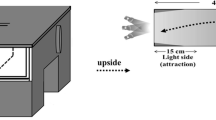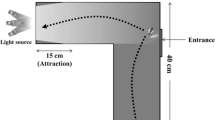Abstract
Phototactic responses of Sitotroga cerealella adults to six light emitting diode (LED) monochromatic lights were investigated, and their responses were compared to that using a luring lamp (BLB). Based on the attraction rate under optimal light conditions, UV LED (365 nm) showed the highest attraction rate (67.7%), followed by blue LED (470±10 nm, 57.7%), green LED (520±5 nm, 44.0%), yellow LED (590±5 nm, 20.3%), red LED (625±10 nm, 18.7%), and infrared LED (730 nm, 11.3%). Moreover, the UV LED was 1.2 times more attractive to S. cerealella adults than that of the BLB (58.0%). These results suggest that UV LED could be more useful for mass trapping and monitoring of S. cerealella adults.
Similar content being viewed by others
References
Ahmed S and Raza A (2010) Antibiosis of physical characteristics of maze grains to Sitotroga cerealella (Oliv.) (Gelechiidae: Lepidoptera) in fee choice test. Pak J Life Soc Sci 8, 142–147.
Boshra SA (2007) Effect of high-temperature pre-irradiation on reproduction and mating competitiveness of male Sitotroga cerealella (Olivier) and their F-1 progeny. J Stored Pro Res 43, 73–78.
Briscoe AD and Chittka L (2001) The evolution of color vision in insects. Annu Rev Entomol 46, 471–510.
Cohnstaedt L, Gillen JI, and Munstermann LE (2008) Light-emitting diode technology improves insect trapping. J Am Mosq Control Assoc 24, 331–334.
Eguchi E, Watanabe K, hariyama T, and Yamamoto K (1982) comparison of electrophysiologically determined spectral responses in 35 species of Lepidoptera. J Insect Physiol 28, 675–682.
Iqbal J, Jilani G, and Aslam M (2010) Growth inhibiting effects plant extracts against the grain moth, Sitotroga cerealella (Oliv.) (Gelechiidae: Lepidoptera). Pakistan J Zool 42, 597–601.
Jeon JH, Oh MS, Cho KS, and Lee HS (2012) Phototactic response of the rice weevil, Sitophilus oryzae Linnaeus (Coleoptera: Curculionidae), to light-emitting diodes. J Korean Soc Appl Biol Chem 55, 35–39.
Lee C, Gillen JI, and Munstermann Le (2008) Light-emitting diode technology improves insect trapping. J Am Mosq Control Assoc 24, 331–334.
Lee HS (2002) Tyrosinase inhibitors of Pulsatilla cernua root-derived materials. J Agric Food Chem 50, 1400–1403.
Nualvatna K, Makathan N, Chavapradit C, Kitkuandee K, and Uraichuan J (2002) The use of light traps for attracting stored-product insects in a rice mill and paddy seed stores. In Advances in stored product protection. International Working Conference on Stored Product Protection, Credland PF, Armitage DM, Bell CH, Cogan PM, and Highley E (8th ed.), pp. 244–247, CABI Pub, UK.
Oh MS and Lee HS (2010) Development of phototactic test apparatus equipped with light source for monitoring pests. J Appl Biol Chem 53, 248–252
Papadopoulou SCH and Bucheols CTH (2002) Comparison of trapping efficacy for Lasioderma serricorne (F.) adults with electric, pheromone, food attractant and control-adhesive traps. J Stored Prod Res 38, 375–383.
Sambaraju KR and Phillips TW (2008) Responses of adult plodia interpunctella (Hübner) (Lepidoptera: Pyralidae) to light and combinations of attractants and light. J Insect Behav 21, 422–439.
Soderstrom and Edwin L (1970) Effectiveness of green electroluminescent lamps for attracting stored-product insects. Entomol Soc Am 63, 726–731.
Tamulaitis G, Duchovskis P, Bliznikas Z, Breivë K, Ulinskaitë R, Brazaitytë A et al. (2005) High-power light-emitting diode based facility for plat cultivation. J Phys D: Appl Phys 38, 3182–3187.
Tran DH, Takagi M, and Takasu K (2004) Effects of selective insecticides on host searching and oviposition behavior of Neochrysocharis Formosa (Westwood) (Hymenoptera: Eulophidae), a larval parasitoid of the American serpentine leafminer. Appl Entomol Zool 39, 435–441.
Yang FL, Zhu F, and Lei CL (2012) Insecticidal activities of garlic substances against adults of grain moth, Sitotroga cerealella (Lepidoptera: Gelechiidae). Insect Sci 19, 205–212.
Yang YC, Lee SG, Lee HK, Kim MK, Lee SH, and Lee HS (2002) A piperidine amide extracted from Piper longum L. fruit shows activity against Aedes aegypti mosquito larvae. J Agric Food Chem 50, 3765–3767.
Yang YC, Lim MY, and Lee HS (2003) Emodin isolated from Cassia obtusifolia (Leguminosae) seed shows larvicidal activity against three mosquito species. J Agric Food Chem 51, 7629–7631.
Yeh N and Chung JP (2009) High-brightness LEDs-energy efficient lighting sources and their potential in indoor cultivation. Renew Sust Energ Rev 13, 2175–2180.
Author information
Authors and Affiliations
Corresponding author
Rights and permissions
About this article
Cite this article
Kim, MG., Lee, HS. Phototactic behavior 5: Attractive effects of the angoumois grain moth, Sitotroga cerealella, to light-emitting diodes. J Korean Soc Appl Biol Chem 57, 259–262 (2014). https://doi.org/10.1007/s13765-014-4079-z
Received:
Accepted:
Published:
Issue Date:
DOI: https://doi.org/10.1007/s13765-014-4079-z




